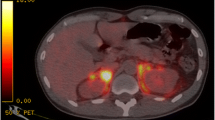Abstract
The aim of this study was to assess the relationship between changes in plasma catecholamine concentrations and intraarterial blood pressure (BP) measured simultaneously during resection of phaeochromocytoma (n = 14). Arterial plasma concentrations of noradrenaline (NA), adrenaline (A) and dopamine (DA) were measured by a radio-enzymatic method. Arterial NA concentrations (pmol/ml; median and Wilcoxon 95% CI) were 71.8 (46,162) before induction of anaesthesia, 113.0 (79,231) after intubation, 375.0 (285,931) during tumour handling and 32.5 (18,88) following tumour removal. Simultaneous mean BP values (mmHg; Mean ± SEM) were 119 ± 8, 114 ± 7, 159 ± 7 (p = 0.0001) and 72 ± 6 (p < 0.0001) respectively. At the time of tumour handling there was a weak correlation between plasma NA and A combined and mean BP (r = 0.583,p = 0.029) and a stronger correlation between log plasma NA and A combined and pulse pressure (r = 0.749,p = 0.008). The very large rises in plasma catecholamine concentrations and in BP are likely to have been causally related. Individual patients maintained a constant ratio of NA to A in plasma from pre-induction to tumour handling (r = 0.916,p < 0.0001). The maintenance of a constant NA: A ratio suggests that the pattern of catecholamine synthesis and release may be a characteristic of the individual tumour.
Similar content being viewed by others
References
Hartley L, Perry-Keene D. Phaeochromocytoma in Queensland — 1970–1983.Aust NZ J Surg 1985;55: 471–475.
Januszewicz W, Wocial B. Clinical and biochemical aspects of phaeochromocytoma. Report of 110 cases.Cardiology 1985;72 (suppl 1): 131–136.
Muneta S, Kawada H, Iwata T, Murakami E, Hiwada K. Impairment of baroreceptor reflex in patients with phaeochromocytoma.J Hum Hypertens 1992;6: 77–78.
Robertson D, Hollister AS, Biaggioni I, Netterville JL, Mosqueda-Garcia R, Robertson RM. The diagnosis and treatment of baroreflex failure.N Engl J Med 1993;329: 1449–1455.
Greaves DJ, Barrow PM. Emergency resection of phaeochromocytoma presenting with hyperamylasaemia and pulmonary oedema after abdominal trauma.Anaesthesia 1989;44: 841–842.
Desmonts JM, Marty J. Anaesthetic management of patients with phaeochromocytoma.Br J Anaesth 1984;56: 781–789.
Jones DH, Reid JL, Hamilton CA, Allison DJ, Welbourn RB, Dollery CT. The biochemical diagnosis, localization and followup of phaeochromocytoma: the role of plasma and urinary catecholamine measurements.Q J Med 1980;49: 341–361.
Gröndal S, Eriksson B, Hamberger B, Theodorsson E. Plasma chromogranin A+B, neuropeptide Y and catecholamines in pheochromocytoma patients.J Intern Med 1991;229: 453–456.
Frewin DB, Jamieson GG, Russell WJ, Chatterton BE, Ropiha C, Boundy KL, Jonsson JR. Extra-adrenal phaeochromocytoma: report of three interesting cases.Aust NZ J Surg 1989;59: 691–695.
Cummings MF, Russell WJ, Frewin DB. The effect of pancuronium and alcuronium on the changes in arterial pressure and plasma catecholamine concentration during tracheal intubation.Br J Anaesth 1983;55: 619–623.
DaPrada M, Zürcher G. Simultaneous radioenzymatic determination of plasma and tissue adrenaline, noradrenaline and dopamine within the femtomole range.Life Sci 1976;19: 1161–1169.
Takeda R, Yasuhara S, Miyamori I, Sato T, Miura Y. Phaeochromocytoma in Japan: analysis of 493 cases during 1973–1982.J Hypertension 1986;4 (suppl 5): S397-S399.
Bachmann AW, Hawkins PG, Gordon RD. Phaeochromocytomas secreting adrenaline but not noradrenaline do not cause hypertension and require precise adrenaline measurement for diagnosis.Clin Exp Pharmacol Physiol 1989;16: 275–279.
Grouzmann E, Comoy E, Bohuon C. Plasma neuropeptide Y concentrations in patients with neuroendocrine tumors.J Clin Endocrinol Metab 1989;68: 808–813.
Krause M, Reinhardt D, Kruse K. Phaeochromocytoma without symptoms: desensitization of the alpha-and beta-adrenoceptors.Eur J Pediatr 1988;147: 121–122.
Hu Z, Azhar S, Hoffman BB. Prolonged activation of alpha 1 adrenoceptors induces down-regulation of protein kinase C in vascular smooth muscle.J Cardiovasc Pharmacol 1992;20: 982–989.
Stenstrom G, Haljamae H, Tisell L-E. Influence of pre-operative treatment with phenoxybenzamine on the incidence of adverse cardiovascular reactions during anaesthesia and surgery for phaeochromocytoma.Acta Anaesthesiol Scand 1985;29: 797–803.
Russell WJ, Kaines AH, Hooper MJ, Frewin DB. Labetalol in the preoperative management of phaeochromocytoma.Anesth Intens Care 1982;10: 160–163.
Author information
Authors and Affiliations
Rights and permissions
About this article
Cite this article
Tonkin, A.L., Frewin, D.B., Russell, W.J. et al. Phaeochromocytoma: Intraoperative changes in blood pressure and plasma catecholamines. Clinical Autonomic Research 4, 167–173 (1994). https://doi.org/10.1007/BF01826182
Received:
Accepted:
Issue Date:
DOI: https://doi.org/10.1007/BF01826182




